





What does it mean to say a plant is toxic? How toxic does a toxic plant have to be to be toxic or non-toxic? That may seem like an odd question, but is one that has bothered me for years, and particularly as I read another senseless, long list of toxic plants on the internet.
What does toxicity mean? This is not such a simple question. Some substances are very mildly toxic, but if one were to ingest enough of it, significant poisoning could occur. If a dog ate 100 lbs of lawn clippings, it would certainly become very ill, possibly even bloat and die. So is grass considered toxic then? This problem with the definition of toxicity can be taken to extremes of course, but it is still an important one to consider when one is perusing the massive volumes of toxic plant lists available today on the internet. When one goes on line and Googles ‘toxic plants' one can find hundreds if not thousands of toxic plant lists, most which I find completely useless if not even counterproductive. A toxic plant is one that if consumed, or touched can potentially cause an adverse reaction in the consumer or handler (often us, or our pets). Well, that could potentially include every plant on the planet if you take the definition literally.
Which is a more dangerous plant to human or pet... a pretty, potted poinsettia (Euphorbia pulcherrima), or a shrubby little strawberry plant? The former is on most if not all of the toxic plants lists and I have not seen the latter on a single one. Yet far more people get sick and die from ingesting strawberries than they do from poinsettias, though most don't normally think of strawberries as toxic plants. Obviously strawberries are not toxic to everyone, but for those that are allergic to them, I would certainly consider them far more dangerous and ‘toxic' than any Euphorbia species. I am not seriously saying one should include strawberries on a toxic plant list. However, a toxic plant list should at least have some more information than just listing the plant name and saying it is toxic. I really think that just making an appearance on a toxic plant list is minimally useful and sometimes very misleading ‘information' about that plant. One really needs to know HOW toxic it is, under what situations it's toxic, how likely is it to be ingested by a pet (if on a pet toxic plant list) or child, what are the toxic principles, what should one do when confronted with a possible toxicity etc. In other words, realistically, how worrisome is this toxic plant?
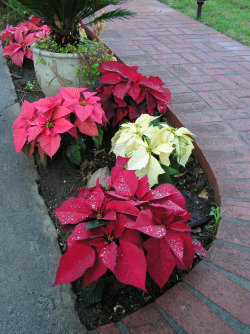
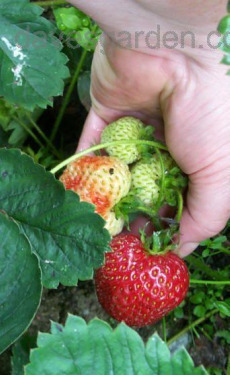
Euphorbia pulcherrima, the common poinsettia (left); strawberry (right photo by Weezingreens). Which kills more people?
Which is more dangerous, an oleander or a poinsettia? Both are on most toxic plant lists, yet rarely is there any distinction about their practical dangers. One is truly deadly toxic and the other is hardly worth mentioning (that would be the poinsettia that really shouldn't even be included in most toxic plant lists since it is only barely toxic). One needs to put the word ‘toxic' in perspective. There are tens of thousands of toxic plants in the world, and I have at least 1000 of them growing in my garden. I have over a dozen pets. Shouldn't I be concerned? Perhaps if I were really careless or purposefully trying to get my pets to eat one of those poisonous plants I would be remiss. But realistically what are the toxic dangers to my pets, and humans in my yard? My neighbor has a huge Oleander tree in his yard with lilies planted around it. Who should be more concerned about their pets or children? These are the sorts of questions I wish most toxic plants lists would at least discuss or touch upon, rather than simply consisting of a mind-numbing list of plant names.
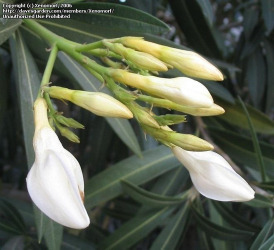
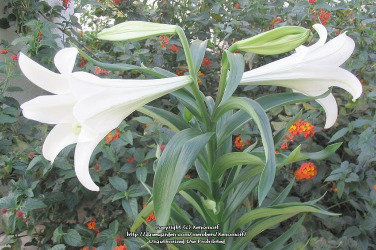
one toxic plant! Nerium oleander (both photos by Xenomorf) Easter Lily- another potentially very toxic plant (particularly to cats)
Which is more dangerous to children or, pet rabbits, deadly nighshade (Atropa belladonna) or oleander (Nerium oleander)? Both are considered among the most toxic plants on the planet. The former is a fairly rare garden plant (for obvious reasons) with berries that unfortunately look a bit like blueberries. Also unfortunately, they do not taste that bad. So deadly nightshade is a truly extremely dangerous plant to children. However, rabbits seem to be completely unaffected by this plant (though few rabbits will ingest much of it). Oleander is nasty tasting stuff so actual poisoning from it in children is far less likely, and one can often find oleander shrubs on school grounds and in parks. Oleander is very toxic to both children and rabbits, though neither are likely to eat them. So I would consider oleander in most situations a potential hazard, but realistically a relatively safe plant to have around. That assessment of oleander would never be included in any toxic plant list unfortunately- too risky (see below)!
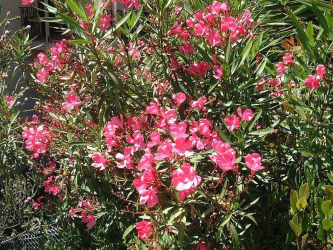
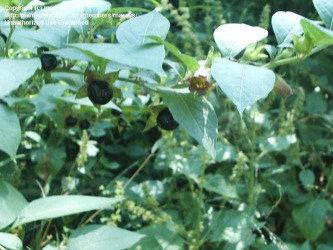
Toxic plant one (oleander)- photo RWhiz Toxic plant two (deadly nightshade)- photo marvcs
Pet rabbits... which plant should concern you more? 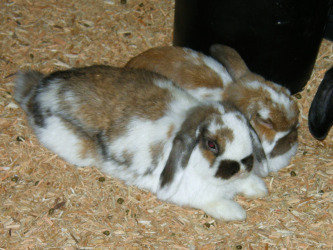
Which is more dangerous to a dog, a huge Oleander shrub (Nerium oleander) with over 5000 leaves, or a small Sago Palm (Cycas revoluta)? Ingesting a single oleander leaf is potentially lethal for a dog. A single cycad leaflet is only mildly toxic to a dog. Yet, realistically, a cycad is much more likely to be ingested in large enough quantities to kill a dog, while oleander leaves, thanks to their horrific flavor, are hardly ever ingested by the most indiscriminate of canines. Cycads are probably one of the more hazardous plants to have around dogs, particularly in climates where they are making fruit and seeds, which are extremely toxic and readily ingested by dogs. Oleander toxicity in small pets is extremely rare. So the cycad is the more dangerous plant.
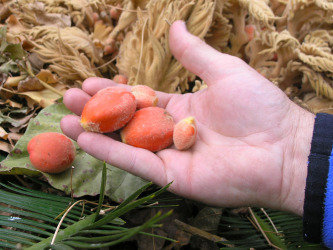 Sago Palm (Cycas revoluta) fruits- very toxic!
Sago Palm (Cycas revoluta) fruits- very toxic!
Which is more dangerous to a person or dog, a large, fruiting cycad or a small Amanita mushroom? The former is potentially deadly toxic with all parts of the plant being poisonous, and may produce enough fruit to kill a hundred or more dogs and people, not to mention being spiny and potentially injurious to eyes and skin as well. The latter is an ephemeral and physically innocuous little wisp of a plant. Yet despite cycads being one of the most commonly encountered plant poisonings in dogs, they still do not taste good and most dogs and children ignore them. Amanita mushrooms, on the other hand, are reportedly rather tasty and therefore much more likely to be ingested by curious canines as well as even the most experienced mushroom collectors and samplers. Also the mushroom kills a lot faster and intervention is far less successful. So realistically, Amanita mushrooms are far more dangerous (thankfully they are not that commonly encountered in the average garden and no one grows them in their garden on purpose).
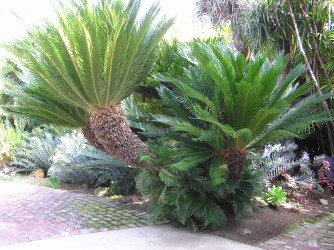
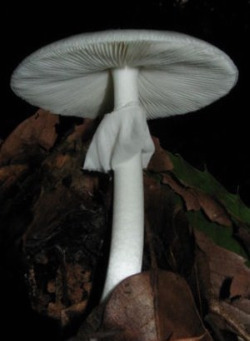 photo Wikipedia
photo Wikipedia
Huge plant with a lot of toxic potential (Cycas revoluta); Small, nearly insignificant plant with incredible toxic potential (deadly Amanita mushroom)
One of the problems of publishing a ‘practical' toxic plant list is the legal ramifications of downplaying the dangers of some plants. If one ignores the mildly toxic plants or the less realistically dangerous ones, and someone or some pet has an atypical or adverse reaction to one of those ‘less hazardous' plants, or somehow just manages to eat enough of one to do damage, one could potentially be held liable for that ‘misinformation', or at least that is my understanding. This is the basic reason that the Dave's Garden PlantFiles has resisted compiling a toxic plant list of its own.
There is at least some fairly useful toxic plant information available on the web. One of my favorite sites includes the ASPCA toxic plant list, which sadly is anything but all-inclusive. But it is at least much more than a simple list of plant names... and of course it is directed toward pets which, as a veterinarian, I find particularly useful. However, it still is woefully lacking of practical information, most notably degree of toxicity. An apple is listed as a toxic plant, but there is no discussion of HOW toxic it is. Sure, apple seeds contain cyanide. But how many apple seeds does a dog, or horse, or even a person realistically need to ingest for this potential poison should be a concern? Should the presence of apple on a toxic plant list keep one from planting apple trees? The ASPCA site says eating apple seeds can cause respiratory distress and shock. Right next to Apple is American Yew, which the site lists respiratory difficulty and seizures as among the toxic effects. But there is no mention that chewing on a bit of yew branch is very likely to kill a dog, while eating a dozen apples (including seeds) is very unlike to do more than make a dog vomit (from simply eating too much fruit). I realize it is the entire apple tree that is also considered toxic... but seriously how often does a dog or person eat and apple tree or even chew on a branch?
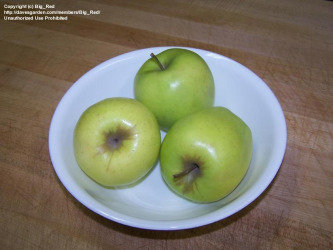
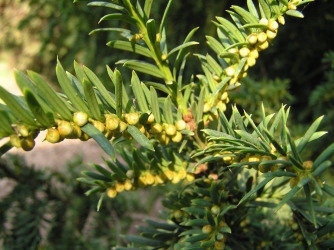
Apples on many toxic plants lists (photo BigRed) a Yew branch (above) IS a very toxic item and for some reason gets chewed now and then
Aloes are listed as toxic because they can make a dog vomit. How many dogs eat grass and vomit? Is grass toxic? Aloes? Come on. Aloes have to be one of the least toxic plants around. And just as an aside, there are many hundreds of Aloe species in cultivation. Are they all toxic? Are really any Aloes truly toxic? Well, as it turns out, there are some truly toxic Aloes, but first of all, they are all pretty rare species (I have only one in my entire collection of 550 aloes, and it was hard to track even this one dinky seedling down). These Aloes should be listed separately, rather than lump all the many hundreds of species of Aloe as one entity? Should I be concerned when one of my dogs decides to eat one (that is unlikely to happen by the way, despite my having over 600 aloes in the yard)? The answer really is no. Realistically aloes are not a dangerous plant to either dogs or children. Why bother to include them on a toxic plant list?
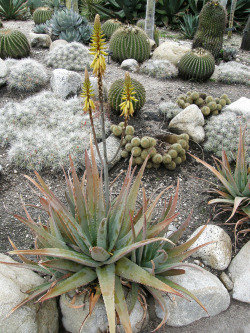
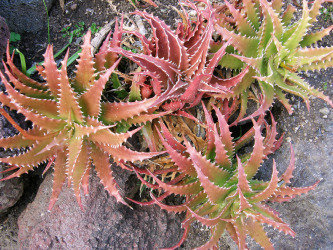
Aloe vera- on many toxic plant list... really?? Aloe dorotheae... is this toxic, too?
I realize that there are no simple answers to my questions nor will there ever be a perfect, all-inclusive and selective toxic plant list. But this is at least food for thought. I suggest that when we peruse toxic plant lists and try to make decisions about which plants to put in our gardens, and even which ones we might consider digging up and getting rid of, we should at least try to put all this ‘information' in perspective and do more research. You might be surprised what you will find about what is really a toxic concern and what is an unfortunate inclusion in just another useless toxic plant list.
In a future article I will list and discuss some of the most toxic plants, and put some perspective on some other commonly feared toxic plants that really shouldn't be.
The following are just a few of the better, but still woefully lacking toxic plant lists. My search on Google.com came up with about 12,000,000 hits (many repeats of course).
http://www.aspca.org/pet-care/poison-control/plants/
http://aggie-horticulture.tamu.edu/plantanswers/publications/poison/poison.html
http://en.wikipedia.org/wiki/List_of_poisonous_plants
Copyright © www.100flowers.win Botanic Garden All Rights Reserved